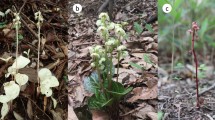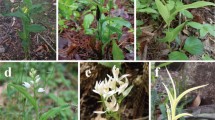Abstract
The genus Pyrola includes species with different degree of mycoheterotrophy; some species possess individuals that rely on all carbon through their associations with fungi (full mycoheterotrophy, FM), whereas some species obtain carbon through both fungi and photosynthesis by itself (partial mycoheterotrophy, PM). To investigate how plant functional traits of photosynthesis and reproduction are related to the degree of mycoheterotrophy in the initial stage of the transition from PM to FM, we determined morphological traits in FM (or nearly FM) and PM species in two independent lineages, P. picta and P. japonica complexes. We used herbarium specimens and examined leaf number, leaf area, flower number, and scape length in FM or nearly FM species (P. aphylla and P. subaphylla) and PM species (P. picta s.l. and P. japonica). We found a leaf area reduction in FM (or nearly FM) species in both lineages, suggesting that this is a convergent trait. The number of flowers was not significantly different between FM (or nearly FM) and PM species in both lineages. On the other hand, differences in the variation between FM (or nearly FM) and PM species were found in some traits between the two lineages. The FM (or nearly FM) species in one lineage only possessed rudimentary leaves, whereas that in the other linage possessed a few small, ordinary leaves in addition to those with only rudimentary leaves. The scape length of the FM (or nearly FM) species was significantly longer than that of PM species in one lineage, whereas it was shorter in the other lineage. The different and common variations are divergent and convergent traits, respectively, that could be associated with the transition to FM in Pylora. In addition, shoots of both PM species occasionally lacked ordinary leaves, possibly indicating possession of these shoots is preadaptation for the transition to FM in Pyrola.





Similar content being viewed by others
References
Camp WH (1940) Aphyllous forms in Pyrola. Bull Torrey Bot Club 67:453–465. https://doi.org/10.2307/2480967
Chen X, Gale SW, Cribb PJ (2009) Gastrodia. In: Wu Z, Raven PH, Hong D (eds) Flora of China, Orchidaceae, vol 25. Science Press, Beijing, pp 201–205
Haber E (1987) Variability, distribution, and systematics of Pyrola picta s.l. (Ericaceae) in Western North America. Syst Bot 12:324–335. https://doi.org/10.2307/2419328
Holm T (1898) Pyrola aphylla: a morphological study. Bot Gaz 25:246–254
Hynson NA, Bruns TD (2009) Evidence of a myco-heterotroph in the plant family Ericaceae that lacks mycorrhizal specificity. Proc R Soc Lond B 276:4053–4059. https://doi.org/10.1098/rspb.2009.1190
Hynson NA, Preiss K, Gebauer G, Bruns TD (2009) Isotopic evidence of full and partial myco-heterotrophy in the plant tribe Pyroleae (Ericaceae). New Phytol 182:719–726. https://doi.org/10.1111/j.1469-8137.2009.02781.x
Hynson NA, Mambelli S, Amend AS, Dawson TE (2012) Measuring carbon gains from fungal networks in understory plants from the tribe Pyroleae (Ericaceae): a field manipulation and stable isotope approach. Oecologia 169:307–317. https://doi.org/10.1007/s00442-011-2198-3
Hynson NA, Schiebold JMI, Gebauer G (2016) Plant family identity distinguishes patterns of carbon and nitrogen stable isotope abundance and nitrogen concentration in mycoheterotrophic plants associated with ectomycorrhizal fungi. Ann Bot 118:467–479. https://doi.org/10.1093/aob/mcw119
Jolles DD (2015) Morphometric analysis of floral variation in the Pyrola picta species complex (Ericaceae): interpretation and implications for ecological and phylogenetic differentiation. Bot J Linn Soc 177:462–480. https://doi.org/10.1111/boj.12244
Jolles DD, Wilson CA (2014) Pyrola crypta: A Pacific Northwest species belonging to the Pyrola picta species complex. Taxon 63:789–800. https://doi.org/10.12705/634.15
Jolles DD, Wolfe AD (2012) Genetic differentiation and crypsis among members of the myco-heterotrophic Pyrola picta species complex (Pyroleae: Monotropoideae: Ericaceae). Syst Bot 37:468–477. https://doi.org/10.1600/036364412X635511
Julou T, Burghardt B, Gebauer G, Berveiller D, Damesin C, Selosse MA (2005) Mixotrophy in orchids: insights from a comparative study of green individuals and nonphotosynthetic individuals of Cephalanthera damasonium. New Phytol 166:639–653. https://doi.org/10.1111/j.1469-8137.2005.01364.x
Lallemand F, Gaudeul M, Lambourdière J, Matsuda Y, Hashimoto Y, Selosse MA (2016) The elusive predisposition to mycoheterotrophy in Ericaceae. New Phytol 212:314–319. https://doi.org/10.1111/nph.14092
Leake JR (1994) The biology of myco-heterotrophic (‘saprophytic’) plants. New Phytol 127:171–216. https://doi.org/10.1111/j.1469-8137.1994.tb04272.x
Liu ZW, Zhou J, Liu ED, Peng H (2010) A molecular phylogeny and a new classification of Pyrola (Pyroleae, Ericaceae). Taxon 59:1690–1700. https://doi.org/10.2307/41059866
Liu ZW, Jolles DD, Zhou J, Peng H, Milne RI (2014) Multiple origins of circumboreal taxa in Pyrola (Ericaceae), a group with a tertiary relict distribution. Ann Bot 114:1701–1709. https://doi.org/10.1093/aob/mcu198
Matsuda Y, Shimizu S, Mori M, Ito S, Selosse MA (2012) Seasonal and environmental changes of mycorrhizal associations and heterotrophy levels in mixotrophic Pyrola japonica (Ericaceae) growing under different light environments. Am J Bot 99:1177–1188. https://doi.org/10.3732/ajb.1100546
Maximowicz CJ (1867) Diagnoses breves plantarum novarum Japoniae et Mandshuriae, Decas tertia. Bull Acad Imp Sci Saint-Pétersbourg 11:433–439
Merckx VSFT. (2013) Mycoheterotrophy: an introduction. In: Merckx VSFT (ed) Mycoheterotrophy the biology of plants living on fungi. Springer, New York, pp 1–17
Merckx V, Schols P, Maas-van de Kamer H, Maas P, Huysmans S, Smets E (2006) Phylogeny and evolution of Burmanniaceae (Dioscoreales) based on nuclear and mitochondrial data. Am J Bot 93:1684–1698. https://doi.org/10.3732/ajb.93.11.1684
Merckx VSFT., Mennes CB, Peay KG, Geml J (2013) Evolution and diversification. In: Merckx VSFT (ed) Mycoheterotrophy the biology of plants living on fungi. Springer, New York, pp 215–244
Motomura H, Selosse MA, Martos F, Kagawa A, Yukawa T (2010) Mycoheterotrophy evolved from mixotrophic ancestors: evidence in Cymbidium (Orchidaceae). Ann Bot 106:573–581. https://doi.org/10.1093/aob/mcq156
Ohwi J, Meyer FG, Walker EH (1965) Flora of Japan (in English). Smithsonian Institution, Washington
Preiss K, Adam IKU, Gebauer G (2010) Irradiance governs exploitation of fungi: fine-tuning of carbon gain by two partially myco-heterotrophic orchids. Proc R Soc Lond B 277:1333–1336. https://doi.org/10.1098/rspb.2009.1966
R Core Team (2013) R: a language and environment for statistical computing. R Foundation for Statistical Computing, Vienna: http://www.r-project.org/. Accessed 11 May 2018
Selosse MA, Roy M (2009) Green plants that feed on fungi: facts and questions about mixotrophy. Trends Plant Sci 14:64–70. https://doi.org/10.1016/j.tplants.2008.11.004
Shutoh K, Kaneko S, Suetsugu K, Naito YI, Kurosawa T (2016) Variation in vegetative morphology tracks the complex genetic diversification of the mycoheterotrophic species Pyrola japonica sensu lato. Am J Bot 103:1618–1629. https://doi.org/10.3732/ajb.1600091
Shutoh K, Izuno A, Isagi Y, Kurosawa T, Kaneko S (2017a) Development of microsatellite markers for partially and putative fully mycoheterotrophic varieties of Pyrola japonica sensu lato (Ericaceae). Genes Genet Syst 92:99–103. https://doi.org/10.1266/ggs.16-00048
Shutoh K, Kaneko S, Kurosawa T (2017b) Taxonomy and distribution of Pyrola subaphylla Maxim. (Pyroleae, Ericaceae). Acta Phytotaxon Geobot 68:181–192. https://doi.org/10.18942/apg.201707
Suetsugu K (2017) Two new species of Gastrodia (Gastrodieae, Epidendroideae, Orchidaceae) from Okinawa Island, Ryukyu Islands, Japan. Phytotaxa 302:251–258. https://doi.org/10.11646/phytotaxa.302.3.4
Takahashi H (1986) Pollen morphology of Pyrola and its taxonomic significance. Bot Mag Tokyo 99:137–154. https://doi.org/10.1007/BF02488816
Takahashi H (1993) Pyrolaceae. In: Iwatsuki K, Yamazaki T, Bouffod DE, Ohba H (eds) Flora of Japan, vol. IIIa: Angiospermae dicotyledoneae sympetalae (a). Kodansha, Tokyo, pp 64–70
Tonkova NA (2013) The morphology of flowers and method of pollination representatives of the subfamily Pyroloidea feps. family Ericaceae Jus. Bull Bot Gard-Inst FEB RAS 10:27–34 (in Russian with English abstract).
Wallace GD (2009) Pterospora. In: Flora of North America Editorial Committee (ed) Flora of North America, vol 8 Magnoliophyta: Paeoniaceae to Ericaceae. Oxford University Press, New York, pp 389–390
Wickham H (2009) ggplot2: Elegant graphics for data analysis. Springer, New York
Zimmer K, Hynson NA, Gebauer G, Allen EB, Allen MF, Read DJ (2007) Wide geographical and ecological distribution of nitrogen and carbon gains from fungi in pyroloids and monotropoids (Ericaceae) and in orchids. New Phytol 175:166–175. https://doi.org/10.1111/j.1469-8137.2007.02065.x
Acknowledgements
We are grateful to M. Briggs and S. Dawson (K), A. Ebihara (TNS), M. Maki and K. Yonekura (TUS), C. Pendry and M. F. Watson (E), N. Murakami (MAK), and H. Nagamasu (KYO) for facilitating the examination of herbarium specimens. This work was supported by the Research Project of Fukushima University for Regeneration of Harmonies between Human Activity and Nature in Bandai-Asahi National Park, the Nichirei Corporation, and a Grant-in-Aid from Japan Society for the Promotion of Science Research Fellowship [No. 15J12267].
Author information
Authors and Affiliations
Corresponding author
Electronic supplementary material
Below is the link to the electronic supplementary material.
Rights and permissions
About this article
Cite this article
Shutoh, K., Suetsugu, K., Kaneko, S. et al. Comparative morphological analysis of two parallel mycoheterotrophic transitions reveals divergent and convergent traits in the genus Pyrola (Pyroleae, Ericaceae). J Plant Res 131, 589–597 (2018). https://doi.org/10.1007/s10265-018-1040-y
Received:
Accepted:
Published:
Issue Date:
DOI: https://doi.org/10.1007/s10265-018-1040-y




